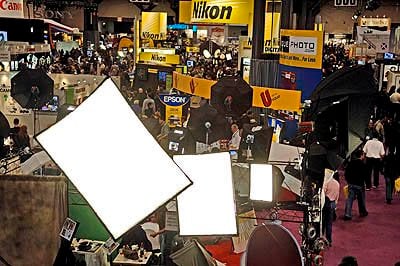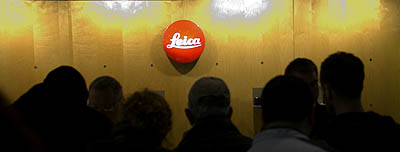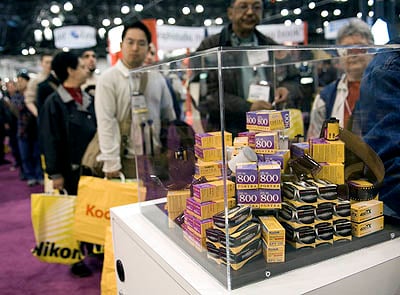PhotoPlus Expo Highlights Changing Digital Landscape

Here are the clichés: “Photography is about communicating your personal vision.” “The camera is only a tool to help communicate what is in your mind’s eye.” “It’s not about the camera, it’s about the photographer.” Yeah, whatever. This is PhotoPlus Expo. It’s all about the stuff!
Maybe that’s not completely true. You can find inspiration and learn much about the art and technique of photography from many top shooters through more than 100 lectures and seminars at New York City’s annual photo trade show. But when it began back in 1984, film was king and the idea of a 10 mega-pixel sensor was science fiction. Remember, there was just 128k of RAM in the then newly introduced Macintosh computer.
Like many in the photo community, I’ve made the pilgrimage to PhotoPlus Expo many times. And though this year’s numbers didn’t break the records set in the mid-1990s, it was the biggest show in recent years, according to show director Jeff McQuilkin, who wandered the 80,000 square feet of digital cameras, printers, computers, software, and every kind of accessory at the Jacob Javits Convention Center.
As I made my way around the show floor (Figure 1), I reaffirmed my view: It’s a great time to be a photographer. Prices are down, quality is up, and the choices, options, and photographic possibilities seem limitless.

Figure 1. This year’s show floor. So much stuff!
Part of what should make us happy is the intense competition fueling the practical and low-cost innovations. There was a definite energy as I maneuvered my way down the narrow aisles with other show-goers gawking as they inched forward to check out the latest stuff.
Much of this energy is generated by this competition. There’s the battle between Aperture versus Lightroom. And let’s not forget Canon, Fuji, Nikon, Sony, Sigma, Pentax, etc., all duking it out for supremacy. There’s also the race for your photo printer dollar, where Epson, HP, and Canon want you to use their machines to show off your work.
An HP representative who likes his job and so wanted to remain anonymous said, “They (Epson) were kicking our butts for the past five years. They were visionary about the fine-art and proofing market. But with the new 12 color Vivera pigment inks on the new HP printers, we have caught up. We’ve got a built-in spectrometer on the new Z3100 printer that builds custom profiles in five easy mouse clicks that nobody else has. We’re late, but we’re here now and we’re here to stay.”
An Epson rep responded, “Our gamut is much larger than their gamut, even with 8 color inks. We’re excited to have competition… finally”. Canon shot back with, “We’ve got 30,000 nozzles, 12 inks, much faster speed and greater quality”.
If this were a schoolyard, I’d say that a fight was about to break out.
I was lucky. I had an expert in my midst to help clear the confusion. Andrew Darlow is a photographer, educator, and digital imaging consultant and has a new book coming out soon that covers many aspects of inkjet printing. His Web site name and slogan is “The Imaging Buffet: A delicious blend of imaging tips, interviews and product reviews.”
“Over the last 10 years,” Andrew explained, “the large-format inkjet printing market has grown considerably, with a large number of printers. But in the world of affordable photo quality pigment-ink based printers, the market has only recently expanded. Canon, Epson, and HP all have new machines targeting fine-art printmakers, advanced amateur and pro photographers, fine-art printmakers, illustrators and other artists.
“Canon has three new printers,” he continued. “The image PROGRAF iPF5000 (17″), iPF8000 (44″), and iPF9000 (60”). The primary feature that’s shared by all three image PROGRAF machines is Canon’s new 12-color Lucia pigment ink-set, which includes Red, Green, and Blue inks to help achieve a very wide color gamut. The printers are also very fast, even at high-quality settings. Another important feature is on the software side. All the printers come with software that allows for direct printing of high-bit files (in 16-bit mode) through a Photoshop plug-in, or directly from Canon RAW files, captured with Canon cameras. Windows users also receive additional software, with artwork to help in the production of posters and other printed materials.
“Epson has four pro-level large format printers on the market,” Andrew said, “from 17 to 44 inches in width: the Epson Stylus Pro 3800 (17″), 4800 (17″), 7800 (24″) and 9800 (44”), all running the UltraChrome K3 pigment inkset. The company’s newest model is the 17 inch wide Epson Stylus Pro 3800, which has a considerably smaller footprint and base weight compared with the Stylus Pro 4800 printer. The Stylus Pro 3800 allows you to print with high Dmax on both matte and glossy papers, without having to manually swap out black inks, saving both time and money. The Epson Stylus Pro 4800 continues to be available and includes a built-in roll paper holder and a media tray for cut sheets up to 17×22 inches.
“HP has released four new printers targeted toward professional photographers,” said Andrew. “The HP Designjet 2100 (an 8-ink model, available in 24- and 44-inch widths), and the HP Designjet Z3100 (available in a 24- and 44-inch wide model, running 11 color inks plus a gloss optimizer). What sets the Z-series printers apart are their built-in GretagMacbeth spectrophotometers, which makes them capable of linearizing and profiling papers right on the machine using step-by-step instructions.
“All three manufacturers’ newest ink sets produce images that have minimal to no bronzing or gloss differential. Bronzing means that dark areas can look bronze on semi-gloss and glossy papers when light hits them at a certain angle, and gloss differential occurs when areas with very little or no ink seem to have a different level of shine on semi-gloss or gloss papers, resulting in an uneven looking print.
“HP takes this a step further with the HP Designjet Z3100, which includes a gloss optimizer ‘ink’ as one of the 12 cartridges. This helps to produce an even smoother look on semi-gloss and gloss papers.
“All three companies also address the issue of black-and-white printing by adding additional shades of gray into their inksets, along with software to help achieve more even-toned monochrome prints, from sepia- to cool-tones,” Andrew concluded. “All three manufacturers have created inks that have been independently tested to resist fading and color shifting for many years — in some cases, hundreds of years.”
For a wealth of information about longevity testing, and an excellent overview of all the printers discussed above, as well as many more, visit https://www.wilhelm-research.com.
Another Fight
Another exciting fight for market supremacy involves two fan favorites with innovative products looking to secure your loyalty. I’m talking about Apple’s Aperture vs. Adobe’s Photoshop Lightroom.
Aperture 1.5.1 had large crowds filling up the seats at the Apple demonstrations, with standing room crowds growing as the demo progressed. (In the spirit of journalistic integrity and full disclosure, know that I’m contributing to the new Aperture Blog.)
And you could see eyes light up from f5.6 to 1.4, as some of Aperture’s coolest features were explained: Color by color adjustment controls, editing with stacks on the light table, the new and improved loupe, and perhaps the biggest obstacle lifted from the original version-images in the Aperture library now can be stored wherever you want them to and the hi-res previews mean you can take your entire library with you on a mobile drive or Powerbook, easily accessing the raw files from a remote location. At the show, Apple announced that a fully functional 30-day Demo was available for download at the Apple site.
On the other side of town, Adobe had mobs gathered around their Lightroom demos, with scores of changes to the latest beta 4.1 release, including enhanced exposure and tone curve controls, improved Slideshow (MP3-based music playback was added to the Windows version), the removal of size limits on the HTML gallery, more responsive searches, and the ability to share images and edits between libraries.
More Cool Stuff
I bumped into Steve Anchell, photographer, workshop leader and editor of Focus Magazine, a beautiful black and white publication dedicated to fine-art photography. Steve was lucky to be running around town with a borrowed and much drooled upon Leica M8 (Figure 2). When you hold it in your hands, it looks and feels like a slightly thicker film Leica M7, and will no doubt be popular among Leica film shooting hold-outs, waiting for a sign to transition into digital. (They will also need about $5k for the body).

Figure 2. You can almost see the copious drooling around the Leica booth from here.
“I got within three feet of the M8 at the crowded Leica booth, and felt its aura”, said Barry Goldstein, who teaches photography at Williams College.
Ted Harris, contributing editor to View Camera Magazine, who has used a large format camera since 1954, pointed out to me that the sheet film market is the only segment of film manufacture that is still growing.
“Film is not dead”, he said, and pointed to the 80 per cent of his readers who are shooting film, then scanning and printing digitally.
At the Kodak booth, one man enquired as to why there were about 75 people waiting to get to the table where a pyramid of film was neatly stacked under glass, like a museum piece (Figure 3).

Figure 3. It looks like the target of a heist in the next Mission: Impossible film.
“Is there some sort of sale?” he enquired.
Not exactly. Kodak was giving away free film. They were flogging their five new Portra color negative films with finer grain, improvements in color (particularly in skin tones) and the price was right. A Kodak representative conceded that 90 per cent of professional photographers had gone digital, “but two thirds of those shooters still shoot some film, often for their personal work,” he added.
Good Idea
Have a great idea for something photographic? Ingenuity and persistence are the commonalities between two relatively new products that are doing very well. The Arctic Butterfly from a company called Visible Dust will clean your cameras digital sensor quickly, and the inexpensive selective focus Lensbabies lenses are gaining popularity with both amateurs and professionals.
Visible Dust is a Canadian Company based in Edmonton, and its principals, both trained in science, developed the Arctic Butterfly while they were doing other research. Rola Hamad and Dr. Fariborz Degan, the inventor, both work with DNA in the biochip technology industry.
Dr. Degan, an amateur photographer, had a bad experience cleaning the sensor of his DSLR, scratching it badly. This bad experience, along with his discovery that dust and DNA had many common characteristics, led him to develop the tool, which uses unique thin polymer brush fibers that spin and attract dust from the sensor.
Photographer Craig Strong was inspired to create Lensbabies when looking for an inexpensive way to add selective focus lenses to his camera bag. He was at his desk when he looked over at an old Speed Graphic he owned, with a 110mm lens and specifically the bellows design, that provided the “eureka” moment. When he came upon a Shop-Vac with its inexpensive bellows-like hose at a hardware store, the Lensbabies would soon be born.
Making Pictures
One of the more frustrating feelings at a show like this is the realization that you won’t get to see and hear all the things you would like to, with many of the more than 100 seminars happening at the same time on the seminar floor as well as in the main showroom.
That being said, I was glad I took in the great, not to mention funny and clever, Martin Parr, who talked about his life’s work and how he likes to challenge himself to make interesting pictures from what many consider boring situations.
He reminds us that all this great and exciting gear is a means to an end, and for us image-makers, it is the end result we are working towards.
That’s best summed up by the great Magnum master Elliot Erwitt, who, when I asked him what his picks for some of the hottest products at the show were, quipped, “I’m really not that interested in equipment”.
Steve Simon’s new book Heroines & Heroes, Hope, HIV and Africa comes out on World Aids Day, December 1. See his work at www.stevesimonphoto.com and on https://www.digitaljournalist.org.
This article was last modified on January 3, 2023
This article was first published on November 6, 2006



